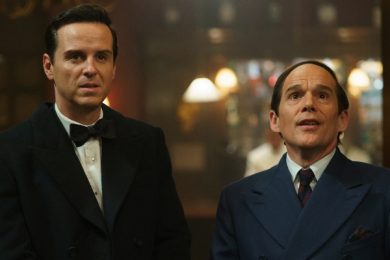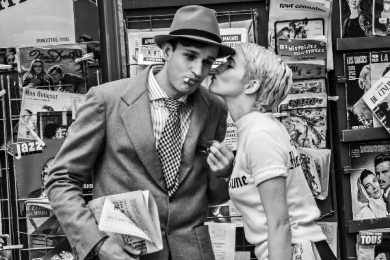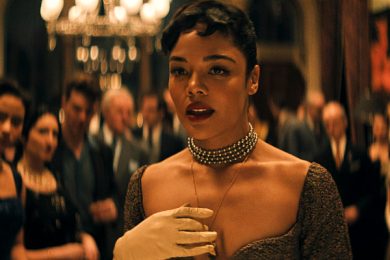There’s a lot of reverence throughout the latest film version of The Color Purple. Firstly, there’s a dedication Alice Walker’s novel, the original text and one of the most beloved pieces of American literature in the Twentieth Century. There are several sincere homages to the 1985 Steven Spielberg film adaptation – a movie that was a narrative turning point for Spielberg and an introduction for many to the likes of Whoopi Goldberg, Oprah Winfrey, and Danny Glover. There’s obvious admiration for the stage musical that premiered in 2004, of which this film is a direct adaptation. There’s even a proper appreciation of the great movie musicals of the past, of which this film emulates without any degree of self-consciousness. Yes, there’s a lot of reverence, but it is also a concrete redefinition, a fresh interpretation for a new time.
This is only the third feature film from director Blitz Bazawule, a Ghanian filmmaker whose impressions have been made mostly as a rapper and record producer. After his debut film in 2018, Bazawule got a larger profile after directing Black is King for mega-star Beyonce. I’ll confess to never seeing Bazawule’s previous work, and perhaps it’s from that ignorance that it seems a great risk for a studio like Warner Bros (a corporation very much at the forefront of Hollywood’s tumultuous labor year) to give him the chance to direct such a major motion picture. Despite all the headlines that Warner has made for their seemingly anti-creative business practices, their 2023 film releases (which includes Barbie) has shown a risk that belies those practices. And in nearly all cases, that risk has paid off.
Earlier this year, I chose to read Walker’s novel and watch Spielberg’s film for the first time, in anticipation of this release. The book, an epistolary story told in a deeply subjective point-of-view, is a fierce, emotionally raw novel that is both explicitly queer and unflinching in its portrayal of hardship and personal tragedy. It’s not something that would exactly lend itself to being a musical. Spielberg’s film softens Walker’s prose and severely tones down the main character’s queer awakening, but it also takes the emotional catharsis that really only resides in the novel’s conclusion, and expertly spreads it over the entire narrative. Spielberg (and the incredible performance from Whoopi Goldberg) takes the character of Celie and turns her victimhood into a sustained triumph of will.
Bazawule’s film is an even further sanding down of Walker’s original story. By becoming a musical in the way that it is, it’s almost a necessity that certain uncomfortable truths are simply alluded to than stated outright. But the core story is still the same: Celie (first played by Phylicia Pearl Mpasi) is a young girl pregnant with her father’s baby. Her first baby, a daughter, was taken by her father and “brought to God”, and the same happens when her son is eventually born. The one light in her life is her little sister, Nettie (Halle Bailey). Nettie is more confident, prettier, and more defiant than Celie, and that defiance shows itself most in her fierce protection of Celie. When their father marries Celie off to a mean sharecropper known as “Mister” (Colman Domingo), the sisters are separated. When Nettie runs away to escape the advances of both Mister and their father, she promises to write to Celie every day.
Years go by, and Celie (now played by Fantasia Barrino) is wasting away in Mister’s abusive household, no letters from Nettie in sight. When Mister’s son, Harpo (Corey Hawkins) marries the independently-minded Sofia (a fantastic Danielle Brooks), Celie catches a glimpse of what it’s like for a woman to stand up to her husband. Things really change with the arrival of Shug Avery (Taraji P. Henson, great as always) a jazz singer with a bad reputation. Shug is the love of Mister’s life, but their marriage was refused by Mister’s ornery father (Louis Gossett Jr.) because of her promiscuousness. Shug fascinates Celie, whose drawn to her free-spirited nature and regal beauty. It’s Shug that shows Celie real passion, and reveals that what she wants from romance may not come from a man. Celie’s continued awakening continues over decades, while the lives of Mister, Shug, Sofia, and eventually Nettie revolve around her.
Spielberg had already shown us that one could mold Walker’s spiky novel into something with broad audience appeal. The difficulty for Bazawule is making the appeal even broader without sacrificing the harsh realities of the book’s story. Being a large scale musical usually means sensitizing the material, but the script (by Marcus Gardley) is smart in recontextualizing the story, and finding the right beats to splice the songs within. The songs, written by Brenda Russell, Allee Willis, and Stephen Bray, span the emotional landscape, between the sprite buoyancy of “Keep It Movin'” to existential triumph of “I’m Here”. A reprise of “Miss Celie’s Blues” from the 1985 film will move those familiar with the story’s history, while the final number, “The Color Purple”, appropriately brings the hammer down and will leave audiences weepy.
If The Color Purple falls short of the grandeur of the classic MGM musicals, it is not for lack of trying. Bazawule crafts the numbers with dozens of background dancers that make proper use of the space, making it a truly cinematic experience. It’s hard to think of the last time Hollywood produced a film this unapologetically theatrical (Chicago??), that takes pride in its numbers instead of trying to sneak them through. Warner’s promotion of the film, which doesn’t even mention that it is a musical, does the movie a great disservice, trying to masquerade its greatest asset as a flaw. Bazawule’s commitment to visualizing the stage musical only gives the movie greater sense of purpose. In The Color Purple, a lot of the work is there to see, but it never feels immodest because the filmmaking is so assured.
Both Barrino and Brooks are reprising roles they played on the stage – albeit, in separate productions. Brooks takes advantage of how ripe the role of Sofia is, maximizing her character’s outsized personality and getting her own killer number, “Hell No!”. Colman Domingo’s Mister, the story’s main villain, is a document of bruised ego and withering masculinity – an embodiment of “hurt people hurt people”. Shug Avery was the best character in Walker’s The Color Purple, but Henson is the first to embody the character’s ferocious spirit while still maintaining the shameless immodesty, an incredible, grandiose performance. And then there’s Barrino, a former American Idol winner and now movie star. Celie is a difficult character if you’re an actor that wants the spotlight. Barrino instead plays what’s best for the story, which ensures the movie’s emotional impact.
This isn’t a perfect film. I could have done with less of Bazawule and cinematographer Dan Laustsen backlighting his characters into oblivion. And in 2023, I think we can make the version of this film that depicts the very real sexual relationship that Shug and Celie have in the book. It’s obvious that Bazawule’s motivation here is excavating the triumph that rises from Celie’s tragedy; and to be sure, The Color Purple‘s beautiful conclusion (if you managed to avoid any version of this story, I won’t mention it here) hits the exact right note, like the 1985 film before it. This film’s main concern is finding the moments of Black joy too infrequently displayed next to Black pain, and in fact seems to argue how the two are explicitly linked in American culture. Quite the statement for a Hollywood film. The Color Purple is often solemn, sometimes defiant, but it is always beautiful.
Directed by Blitz Bazawule










